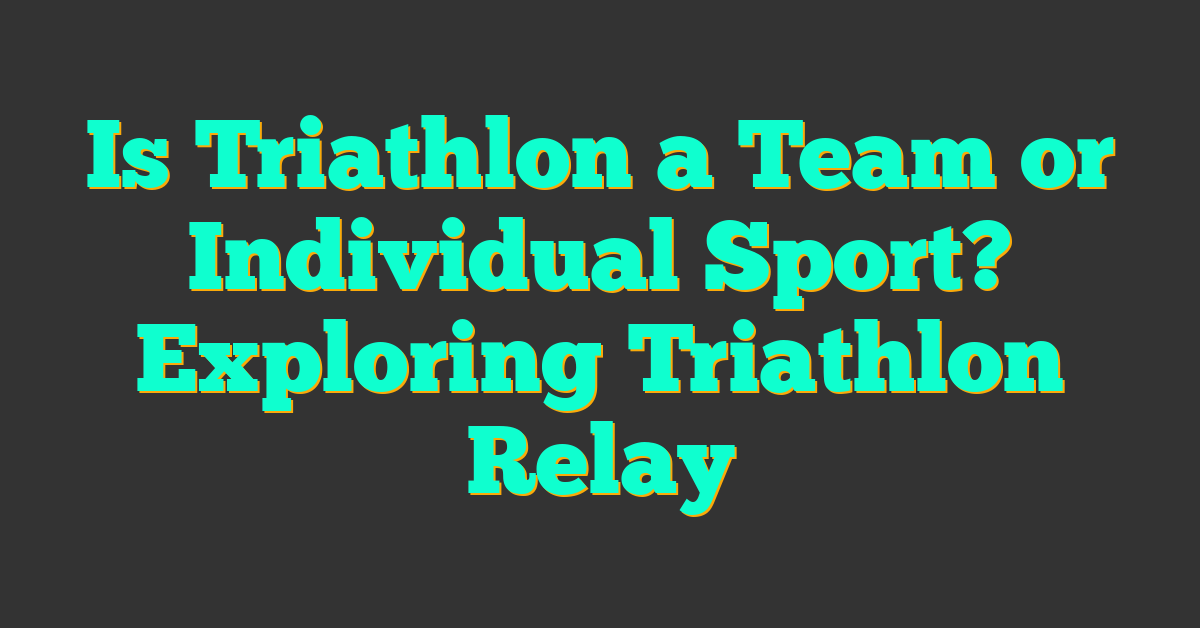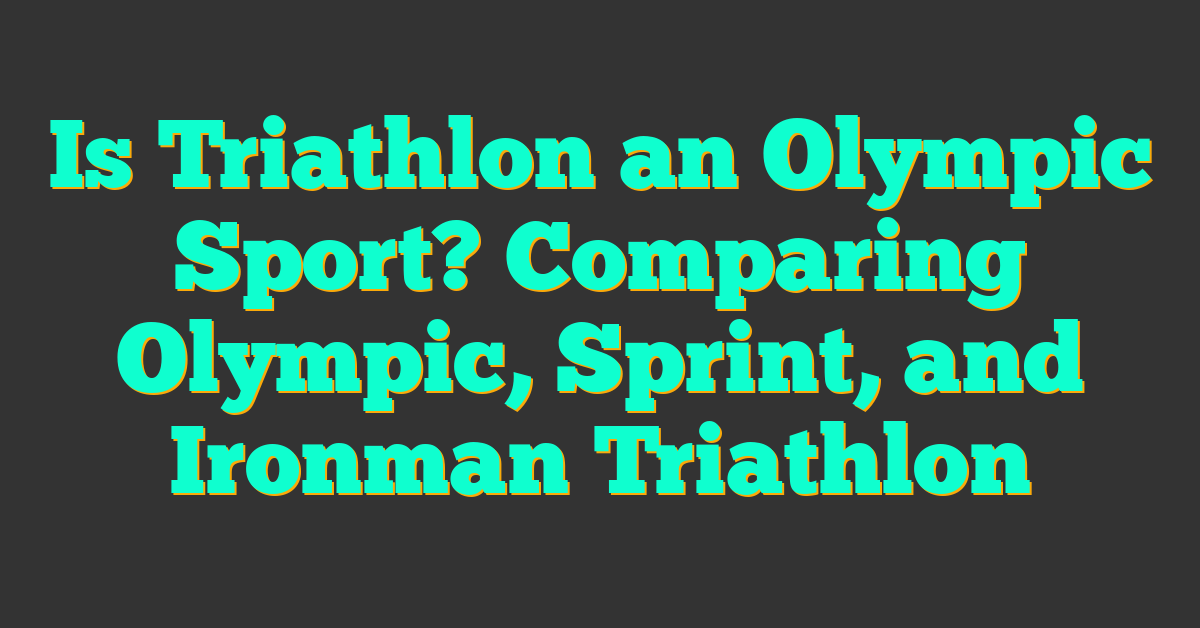Triathlon is a sport that requires participants to complete three different disciplines consecutively: swimming, cycling, and running. It is a challenging sport that requires dedication, discipline, and endurance. If you are interested in participating in a triathlon, it is important to understand the age groups in a triathlon, as they can vary depending on the event and location.

Understanding Triathlon Age Groups is crucial because it determines who you will be competing against in the race. Age groups in triathlons are typically structured in five-year increments to keep athletes of roughly the same ages in one group. For example, the age groups for USA Triathlon are 18-19, 20-24, 25-29, 30-34, 35-39, 40-44, 45-49, and so on. It is important to note that some triathlon race organizers may have different age group categories, so make sure to check the specific rules and regulations for the event you plan on participating in.
Key Takeaways
- Triathlon age groups are typically structured in five-year increments.
- Age groups can vary depending on the event and location.
- Make sure to check the specific rules and regulations for the event you plan on participating in.
Understanding Triathlon Age Groups
https://www.youtube.com/watch?v=Hmnnit-aLyI&embed=true

If you’re new to triathlons, you may be wondering how age groups work. Age groups are categories that separate athletes based on their age and gender. This grouping allows athletes to compete against others in their age range, ensuring fair competition.
Defining Age Groups
Typically, triathlon age groups are structured in five-year increments, as set out by USA Triathlon. This means that athletes aged 15 and under will compete in a different age group than those aged 16 to 19, and so on. The most common age groups you’ll encounter at a typical race are:
- 15 years and under
- 16 to 19 years old
- 20 to 24 years old
- 25 to 29 years old
- 30 to 34 years old
- 35 to 39 years old
- 40 to 44 years old
- 45 to 49 years old
- 50 to 54 years old
It’s important to note that some races may change the age groups slightly, so be sure to check the registration information for the specific race you’re interested in.
Age Group Categories
There are two main age group categories in triathlons: elite and age-group. Elite triathletes are those who compete at a professional level, while age-group triathletes are non-professional athletes who compete in events according to age groups.
As an age-grouper, you will compete against others in your age range and gender, within a five-year band. For example, if you’re a 35-year-old male, you’ll compete against other males aged 35 to 39.
Knowing your age group is important because it determines your competition and can help you set realistic goals for your training. It’s also helpful to know the age groups of your competitors so you can gauge your performance against theirs.
In summary, understanding triathlon age groups is essential for fair competition. With age groups, athletes can compete against others in their age range and gender, ensuring equal opportunities for all. Knowing your age group can also help you set realistic goals and gauge your performance against others in your category.
Race Formats and Distances
https://www.youtube.com/watch?v=OHbE_-qNFmU&embed=true
When it comes to triathlons, there are several race formats and distances to choose from. Below we’ll explore the most common ones.
Sprint and Super Sprint
The sprint and super sprint triathlon distances are perfect for beginners or those who want to try out the sport without committing to a longer race. The sprint distance typically includes a 750-meter swim, 20-kilometer bike ride, and 5-kilometer run. Meanwhile, the super sprint is even shorter, usually consisting of a 400-meter swim, 10-kilometer bike ride, and 2.5-kilometer run. These distances are great for those who want to test their endurance and speed.
Olympic and Standard Distance
The Olympic and standard distance triathlons are more challenging than the sprint and super sprint distances. The Olympic distance includes a 1.5-kilometer swim, 40-kilometer bike ride, and 10-kilometer run. The standard distance, also known as the “half-ironman,” is twice the distance of the Olympic triathlon. It includes a 1.9-kilometer swim, 90-kilometer bike ride, and 21.1-kilometer run. These distances are ideal for intermediate-level triathletes who want to push themselves to the next level.
Long Distance and Ironman
Long distance and Ironman triathlons are the ultimate challenge for any triathlete. The long-distance triathlon usually includes a 3-kilometer swim, 80-kilometer bike ride, and 20-kilometer run. Meanwhile, the Ironman distance is the longest and most challenging of all triathlons. It includes a 3.8-kilometer swim, 180-kilometer bike ride, and 42.2-kilometer run. These distances are reserved for experienced triathletes who have trained for months or even years to complete the race.
No matter which race format or distance you choose, make sure to train properly and listen to your body to avoid injury. Remember, triathlons are a test of endurance, not just speed. So take your time and enjoy the journey.
Participation and Qualification

Triathlons are open to athletes of all ages and skill levels. There are different categories of participation and qualification for triathlon events. In this section, we will discuss the different categories of participation and how to qualify for major competitions.
Amateur and Club Participation
Amateur athletes make up the core of the triathlon community. Anyone who does not have a pro/elite license is considered an age-grouper and they race in events according to age groups, typically separated in five-year increments. Athletes are separated into five-year age groups, starting from 18-19, 20-24, and so on, up to 90+. Most races ask you to sign up in the age group which matches your age on the day of the race.
Triathlon clubs are a great way to get involved in the sport and meet other athletes. Clubs offer training sessions, group rides, and social events. Joining a club can also provide opportunities to participate in race series and other events.
Elite Athlete Competition
Elite athletes compete in separate races from age-groupers. Elite races are typically shorter and faster than age-group races. Elite athletes are required to have a pro/elite license and must meet certain performance standards to qualify for major competitions.
Qualifying for Major Competitions
« What are Swimming Resistance Bands? How to Properly Benefit from Them
What Are Triathlon Race Cutoff Times? Tips for Achieving a Good Finish Time »
To qualify for major competitions, such as the World Triathlon Championships, athletes must represent their national federation. Qualification criteria vary by country and competition. In the United States, athletes can qualify for Team USA by placing in the top 18 of their age group at the qualifying race. USAT 2023 triathlon rankings will be used to fill remaining slots.
In conclusion, triathlon is a sport that welcomes athletes of all ages and skill levels. Whether you are an age-grouper, an elite athlete, or a member of a triathlon club, there are opportunities to participate and compete. Qualifying for major competitions requires dedication and hard work, but the rewards are worth it.
Event Categories Beyond Triathlon

If you’re looking to expand your triathlon experience, there are several other event categories that you might want to consider. These categories include duathlon, aquathlon, winter triathlon, and cross triathlon. Each of these categories offers a unique set of challenges and can provide you with a new and exciting way to test your endurance and skill.
Duathlon and Aquathlon
Duathlon is a multisport event that combines running and cycling, with no swimming involved. Typically, duathlon events consist of a run-bike-run format, with distances varying depending on the event. Aquathlon, on the other hand, is a multisport event that combines swimming and running, with no cycling involved. Aquathlon events usually consist of a swim-run format, with distances also varying depending on the event.
Both duathlon and aquathlon are great options if you’re looking to mix up your training routine or if you’re not comfortable with the swimming aspect of triathlon. These events can be a great way to challenge yourself and improve your overall fitness.
Winter Triathlon and Cross Triathlon
Winter triathlon is a multisport event that combines cross-country skiing, mountain biking, and running. This event is typically held in the winter months and is a great way to stay active and continue training during the colder months of the year. Cross triathlon, on the other hand, is a multisport event that combines off-road triathlon disciplines such as mountain biking, trail running, and open water swimming.
If you’re looking for a new and exciting way to challenge yourself, both winter triathlon and cross triathlon can provide you with a unique and challenging experience. These events are a great way to test your skills and endurance in a new environment and can be a great way to stay motivated and engaged in your training.
No matter which event category you choose, it’s important to remember that each discipline requires a different set of skills and training. Whether you’re competing in triathlon, duathlon, aquathlon, winter triathlon, or cross triathlon, be sure to train accordingly and always listen to your body. With the right mindset and training, you can conquer any multisport event that comes your way.
Gender and Special Divisions

Male and Female Categories
In triathlons, male and female athletes are separated into different age groups. The age groups typically range from 15 years old and under to 60-64 years old. Each age group is separated by a five-year range. For example, the male age groups are 19 and under, 20-24, 25-29, 30-34, 35-39, 40-44, 45-49, 50-54, 55-59, and 60-64. Female age groups are typically the same, but some races may have slight variations.
Athena and Clydesdale Groups
In addition to the standard male and female categories, some triathlons have special divisions for athletes who may not fit into the traditional mold. The Athena and Clydesdale groups are two such divisions.
The Athena division is for women who weigh 165 pounds or more. The Clydesdale division is for men who weigh 220 pounds or more. These divisions provide a way for larger athletes to compete against others who are similarly sized.
It’s important to note that these divisions are not meant to discriminate against athletes who are larger or smaller than the average athlete. They are simply a way to level the playing field for athletes who may have different body types.
Whether you are an elite athlete or an amateur, there is a place for you in the world of triathlons. With a variety of age groups and special divisions, there is a way for everyone to compete and challenge themselves.
Organizational Structure and Rules
https://www.youtube.com/watch?v=qaI8v_4q8fE&embed=true
When it comes to triathlon, there are a few key organizations that help to organize and regulate the sport. Understanding these organizations and their rules can help you get the most out of your triathlon experience.
Triathlon Clubs and Coaching
Joining a triathlon club can be a great way to meet other triathletes, get coaching, and find training partners. Many clubs offer group workouts, clinics, and social events. Coaching can also be a great way to improve your performance and reach your goals. A coach can help you with everything from training plans to race strategy.
USA Triathlon and World Triathlon
USA Triathlon is the national governing body for the sport of triathlon in the United States. They are responsible for sanctioning races, setting rules, and promoting the sport. World Triathlon is the international governing body for the sport. They oversee the sport at the international level, including the Olympic and Paralympic Games.
Both organizations have age group categories for competitive events. USA Triathlon has age groups in five-year increments, starting at age 15 and going up to 90+. World Triathlon also has age groups in five-year increments, starting at age 16 and going up to 80+.
It’s important to note that while these organizations set rules and regulations for the sport, they also rely heavily on volunteers to help run races and events. Volunteering can be a great way to get involved with the sport and give back to the community.
In summary, understanding the organizational structure and rules of triathlon can help you get the most out of your experience. Joining a triathlon club or getting coaching can help improve your performance, while understanding the rules and regulations set by USA Triathlon and World Triathlon can help you compete at your best. And don’t forget to give back by volunteering at events!
Frequently Asked Questions
https://www.youtube.com/watch?v=13Bjb2dsPxk&embed=true
How are age groups categorized in triathlon competitions?
Age groups in triathlon competitions are categorized by five-year increments. According to USA Triathlon, the age group categories are as follows: 18-19, 20-24, 25-29, 30-34, 35-39, 40-44, 45-49, 50-54, 55-59, 60-64, 65-69, 70-74, 75-79, and 80+.
What are the different triathlon categories for various skill levels?
There are various triathlon categories for different skill levels. The most common categories are sprint, Olympic, and Ironman. Sprint triathlons are usually the shortest distance and are perfect for beginners. Olympic triathlons are longer than sprint triathlons and are usually for more experienced athletes. Ironman triathlons are the longest and most challenging triathlons and are only recommended for highly experienced athletes.
Can you explain the Masters category in triathlon?
The Masters category in triathlon is for athletes who are 40 years old and above. The age group is further divided into five-year increments, and the oldest age group is usually called the Grand Masters. Some races also have a Super Grand Masters category for athletes who are 70 years old and above.
What is the Clydesdale category in triathlons?
The Clydesdale category in triathlons is for male athletes who weigh more than 220 pounds. Female athletes who weigh more than 165 pounds are usually placed in the Athena category. The Clydesdale and Athena categories are not recognized by all races, but they are a great way for larger athletes to compete against each other.
Where can I find information about the National Age Group Triathlon events?
You can find information about the National Age Group Triathlon events on the USA Triathlon website. The website has information about the different events, including the dates, locations, and registration details.
Are there any monetary rewards for age group triathletes?
There are usually no monetary rewards for age group triathletes. However, some races offer prizes or awards for the top finishers in each age group. The main goal of age group triathletes is to compete against other athletes in their age group and improve their personal best times.










